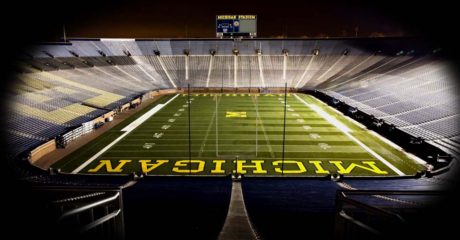
As you can see by the somewhat muddled pie chart above (click it to enlarge), I’ve compiled some statistics from the
2010 offer board. I’m no computer expert, so my talents will grow, but bear with me in the meantime. Anyway, this is the beginning of a short series of posts regarding the distribution of Michigan offers.
Throughout the 2010 recruiting cycle, I did my best to keep a running tab on which players throughout the country were offered by Michigan. The list developed by using recruiting sites (Rivals and Scout) and newspaper articles. Not all newspaper articles and recruiting profiles are 100% accurate, but their validity can be hard to verify.
There are some odd examples that should be identified. For example, Jamaal Jackson is a running back from Newark, Delaware. As of February 9, 2010, he has yet to choose a school, but his Rivals profile lists him as having offers from several BCS programs, including Michigan, Boston College, and Rutgers, among others. There’s also the case of Travis Williams, a cornerback from Cooper City, Florida. He tried to commit to Michigan in the spring of 2009, but was “encouraged” by Michigan’s coaches to weigh all of his options. Williams was never heard from again on Michigan’s radar and ended up signing a letter of intent to Miami-OH, but I kept him on the list, as it appears he had been offered by Michigan before the coaches cooled on him.
And then there’s cornerback Adrian Witty. Witty was a high school teammate of Denard Robinson’s in Deerfield Park, Florida, and committed to Michigan in 2009. However, he failed to qualify and took an evening class in the fall of 2009 in order to enroll for January 2010. He passed the class but was somehow denied admission to Michigan. According to rumor, Rich Rodriguez put in a good word for Witty with new Cincinnati coach Butch Jones, and Witty signed his LOI to play for Cincinnati as a member of the class of 2010. Considering that Michigan’s coaches wanted him at Michigan, I also include him on the 2010 Offer Board.
Back to the analysis:
A plurality of offers were extended to recruits from Florida – 46 out of the 190 total offers, in fact. This makes some sense, as Michigan received 7 commitments from the state of Florida in 2009. However, Michigan only secured 3 recruits from Florida in 2010, which is slightly less than 7% of the offers tendered. If Michigan had that kind of success rate nationally, they would need to offer 415 players in order to get 27 commitments.
The Wolverines also made a significant attempts to recruit in Michigan’s geographic footprint, with 56 offers going to players from Michigan (10), Ohio (30), Pennsylvania (11), Indiana (3), Illinois (1), and Wisconsin (1). As would be expected, the percentage of commitments from those areas are significantly higher than in Florida; 34% of offered prospects in that midwest section accepted their offers.
A total of 25 offers went to recruits from talent-rich states Georgia and Texas. Only one of those recruits accepted.
Meanwhile, Michigan pursued 10 kids from Maryland, a small but relatively populous state that has excellent football programs with the likes of DeMatha and Our Lady of Good Counsel. One (Josh Furman, from Old Mill High School) accepted.
There was a smattering of other offers, as illustrated by the chart above. But we can see that Michigan is going hard after kids in the Deep South (Florida, Georgia, Texas, Louisiana, South Carolina) and in the Upper Midwest (Michigan, Wisconsin, Illinois, Indiana, Ohio, Pennsylvania). Beyond those states, Rich Rodriguez seems to only be making cursory efforts in the Great Plains (A.J. Derby from Iowa), the West Coast (12 from California, 1 from Arizona, 1 from Utah, and none from Oregon or Washington), and the Northeast (such as Dominique Easley from New York and Khairi Fortt from Connecticut). The 12 from California might seem like a high number, until one considers that 48 players from the state were rated 4-stars or higher by Rivals; California is a gold mine of football talent.
We know for certain that Michigan will continue recruiting Florida, Ohio, and Pennsylvania hard. I also expect the Wolverines to offer more than 10 in-state prospects for the class of 2011; six offers have already been extended.
All coaches’ recruiting strategies continue to evolve, and I don’t expect anything different from Rich Rodriguez. He was largely unsuccessful in the deep south. I expect that he’ll try to make some more inroads in Texas, a perennially talent-rich state, but perhaps ignore Georgia recruiting a bit more. Offers will go where the talent is, but it’s a waste of time and resources to recruit heavily in states where the players don’t want to leave home, are afraid of playing in cold weather, or have enough traditionally powerful in-state programs to suck up all the local talent.



.jpg)
.jpg)

